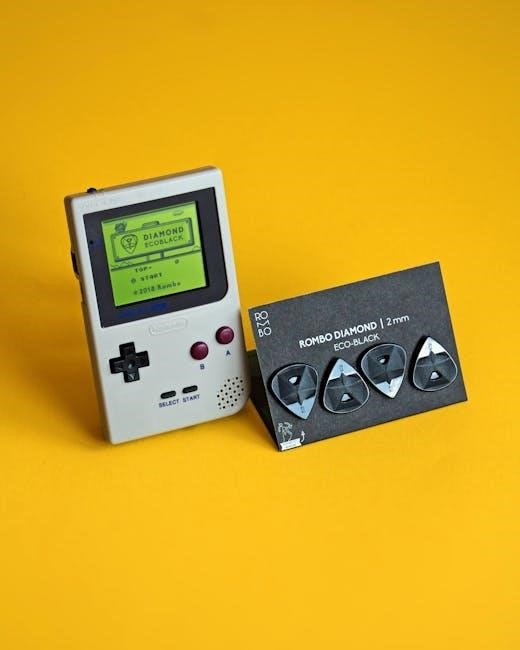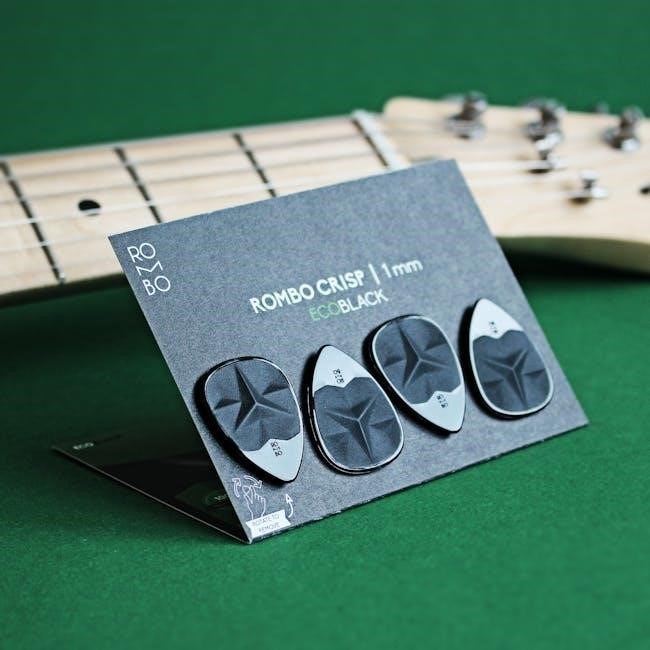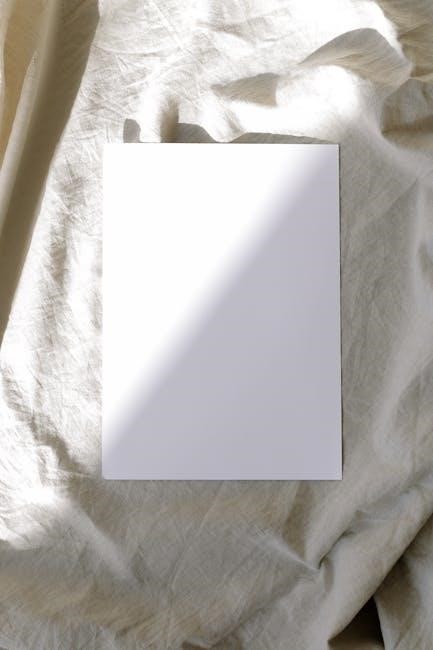Card stock thickness is a critical factor in determining its durability and usability for various projects․ Measured in points, pounds, or GSM, it ensures the right balance of rigidity and flexibility, making it essential for achieving professional results in crafting, printing, and design applications․ Understanding thickness helps in selecting the perfect stock for projects like greeting cards, scrapbooking, or business cards, ensuring optimal performance and aesthetic appeal․
Understanding the Importance of Card Stock Thickness
Card stock thickness plays a pivotal role in determining its durability, rigidity, and overall usability․ Thicker stocks offer greater stability and a premium feel, making them ideal for professional applications like business cards or luxury packaging․ Lighter weights, while less rigid, provide flexibility for crafts such as paper flowers or layering․ The right thickness ensures projects maintain structural integrity while meeting aesthetic demands․ For instance, heavyweight cardstock resists bending, making it perfect for high-end products, while lighter options excel in delicate designs․ Balancing thickness with intended use is key to achieving desired results, whether for personal crafting or professional printing․ This balance ensures optimal performance and visual appeal in every application․

How Card Stock Thickness is Measured
Card stock thickness is measured in points (pts), with one point equal to 0․001 inches, or in pounds (lb), reflecting weight per 500 sheets of uncut size․

Points (pts) and Inches
Card stock thickness is commonly measured in points (pts), where one point equals 0․001 inches․ This system quantifies the physical thickness of the paper, providing a clear indication of its rigidity and flexibility․ For example, a 10pt card stock measures 0․010 inches thick, while a 14pt stock is 0․014 inches․ Thicker stocks, such as 16pt or 18pt, are often used for high-end applications like luxury packaging or premium business cards, offering a sturdy, durable finish․ Understanding points and inches helps crafters and designers choose the right thickness for their projects, ensuring the desired balance between sturdiness and pliability․ This measurement system is widely used in the paper and printing industries to standardize thickness specifications․
Pounds (lb) and GSM (Grams per Square Meter)
Card stock weight is measured in pounds (lb) and grams per square meter (GSM), providing a universal standard for comparing thickness and durability․ In the U․S․, pounds refer to the weight of 500 sheets of uncut paper, while GSM measures grams per square meter, offering a more consistent international standard․ For instance, 80 lb card stock is equivalent to approximately 216 GSM, indicating a medium-weight paper suitable for greeting cards and scrapbooking․ Heavier stocks, like 100 lb (270 GSM), are ideal for business cards and projects requiring rigidity․ Understanding these measurements helps users select the appropriate card stock for their needs, ensuring the right balance of strength, flexibility, and professional appearance․ This dual system allows for easy comparison and selection across different regions and applications․

Common Card Stock Thickness Options
Card stock thickness options range from lightweight (65-80 lb) for layering, medium (80-100 lb) for general use, and heavyweight (100-110 lb) for durable applications, ensuring versatility in crafting and professional projects․
Lightweight Card Stock (65-80 lb)
Lightweight card stock, ranging from 65 to 80 lb, is ideal for projects requiring flexibility and moderate durability․ At 65 lb, it is perfect for layering, die-cutting, and creating paper flowers due to its pliability․ Slightly heavier, 80 lb card stock offers more stability while still being lightweight, making it suitable for scrapbook layouts, greeting card bases, and invitations․ This range is thicker than standard printer paper but retains a level of flexibility, ensuring it can be easily shaped or cut without tearing․ Its versatility makes it a favorite for crafters and designers seeking a balance between ease of use and professional-quality results․ However, it may not be sturdy enough for projects requiring heavy-duty rigidity or long-term outdoor use․
Medium-Weight Card Stock (80-100 lb)
Medium-weight card stock, spanning 80 to 100 lb, strikes a balance between durability and versatility, making it a popular choice for various projects․ At 80 lb, it is sturdy enough for scrapbook bases, handmade cards, and die-cutting, while still being flexible․ As the weight increases to 100 lb, the stock becomes more rigid, ideal for wedding invitations, business cards, and DIY boxes․ This range is favored by crafters and professionals alike, offering a robust feel without excessive bulk․ It handles printing, embossing, and watercoloring well, maintaining minimal warping․ However, heavier weights in this range may be less pliable, making them less suitable for intricate folding or detailed shaping․ Overall, medium-weight card stock is a reliable option for projects requiring both strength and adaptability․
Heavyweight Card Stock (100-110 lb)
Heavyweight card stock, ranging from 100 to 110 lb, offers exceptional durability and a premium feel, making it ideal for projects requiring strength and rigidity․ At 100 lb, it is commonly used for wedding invitations, business cards, and DIY boxes, providing a sturdy base that resists bending․ This weight is also favored for handmade card bases, as it stands up well when displayed․ The 110 lb option is nearly chipboard-thick, perfect for intricate die-cutting and layering, where stability is crucial․ While it is less pliable for shaping, its robustness makes it a top choice for professional applications․ Heavyweight card stock is versatile, working well with tools like die-cutting machines and Cricut devices, ensuring crisp cuts and a polished finish․ Its thickness and weight make it a reliable option for high-end projects and durable crafts․

Choosing the Right Thickness for Your Project
Selecting the appropriate card stock thickness involves considering the project’s requirements, such as durability, flexibility, and compatibility with tools․ Lightweight options (65-80 lb) are ideal for layering and delicate crafts, while medium-weight (80-100 lb) balances versatility and sturdiness for everyday use․ Heavyweight stocks (100-110 lb) are best for high-end applications like business cards or wedding invitations, offering rigidity and a premium feel․ Understanding the project’s needs ensures the chosen thickness enhances both functionality and aesthetics, providing optimal results for crafting, printing, or professional use․
Greeting Cards and Invitations
Greeting cards and invitations require a balance of durability and elegance․ A medium-weight card stock, typically between 80-100 lb, is ideal for these projects․ The 80 lb option offers a sturdy yet flexible feel, making it easy to handle and print․ For a more premium look, 100 lb card stock provides additional rigidity, though it may be less pliable․ Popular sizes include A7 (5×7 inches) and square cards (5×5 inches), which are widely used for their visually appealing formats․ When designing, consider the fold and bleed area to ensure a professional finish․ The thickness ensures the card stands up well when displayed and withstands mailing․ Additionally, finishes like pearlescent or metallic can enhance the aesthetic appeal, making the card stock a perfect choice for special occasions․ This range of weights and sizes ensures versatility for various design needs, from casual to formal events․
Scrapbooking and Layering
Scrapbooking and layering projects benefit from card stock that offers both stability and creativity․ A medium-weight option, such as 80-100 lb, is often preferred as it provides a sturdy base for scrapbook pages․ For those who enjoy extensive layering, a heavier 100-105 lb card stock is ideal, as it holds embellishments without bending․ Textured card stocks, like Bazzill Basics (80 lb), add depth and interest to layouts․ Lighter weights, such as 65-80 lb, are great for intricate die-cutting and layering elements․ Balancing the base weight with layering materials ensures a polished, professional look․ Crafters can choose from a variety of finishes and textures to enhance their designs, making card stock a versatile medium for preserving memories and creating artistic compositions․ Proper selection ensures durability and aesthetic appeal in every scrapbooking project․
Business Cards and Professional Use
When it comes to business cards and professional use, the thickness of card stock plays a crucial role in making a lasting impression․ A heavier weight, typically between 100-110 lb (or 14-16 pt), is preferred for its durability and premium feel․ This thickness ensures the card withstands wear and tear while maintaining a professional appearance․ Popular choices include 100 lb cover weight, which is sturdy yet flexible, and 105 lb options like Neenah Stardream for a luxurious finish․ These weights are ideal for printing, embossing, or watercolor techniques, and they resist warping․ For a polished look, 110 lb card stock is nearly chipboard-thick, offering exceptional rigidity․ Selecting the right thickness ensures your business cards convey professionalism and leave a memorable impression on clients and colleagues․
Factors Influencing Card Stock Thickness Selection
The thickness of card stock chosen depends on factors like durability needs, compatibility with printing and cutting tools, and the specific requirements of the project․ Thicker stocks, such as 100-110 lb, offer greater rigidity and are ideal for professional uses like business cards, while lighter options, such as 65-80 lb, are better for crafts requiring flexibility, like paper flowers․ Additionally, the type of printing equipment and cutting tools, such as die-cutting machines, can influence the selection, as thicker stocks may not work well with all tools․ Ultimately, the right thickness ensures the project meets aesthetic and functional goals, balancing sturdiness with usability․
Durability and Rigidity Needs
Durability and rigidity are key considerations when selecting card stock thickness․ Thicker stocks, typically 100 lb or higher, provide enhanced durability and resistance to bending, making them ideal for projects requiring structural integrity, such as premium business cards, wedding invitations, or DIY boxes․ Medium-weight stocks (80-100 lb) strike a balance, offering sufficient rigidity for scrapbook layouts and handmade card bases without being overly bulky․ Lightweight options (65-80 lb) are better suited for applications where flexibility is important, like layering or paper flowers․ Assessing the project’s need for sturdiness helps determine the appropriate thickness, ensuring the final product meets both functional and aesthetic expectations while maintaining usability․ This balance is crucial for achieving professional results and longevity in various crafting and design applications․
Compatibility with Printing and Cutting Tools
Compatibility with printing and cutting tools is essential when choosing card stock thickness․ Thicker stocks, such as 100 lb or higher, are ideal for high-end applications like business cards or luxury packaging, where durability and a premium feel are required․ Medium-weight stocks (80-100 lb) are versatile and suitable for most projects, including scrapbooking and die-cutting, offering a balance of sturdiness and ease of use․ Lightweight options (65-80 lb) are perfect for intricate designs, such as paper flowers or layered greeting cards, where flexibility and pliability are key․ Ensuring the card stock aligns with your tools and techniques is vital for achieving crisp cuts, vibrant prints, and professional finishes․ This compatibility ensures seamless execution and enhances the overall quality of your projects․



0 Comments